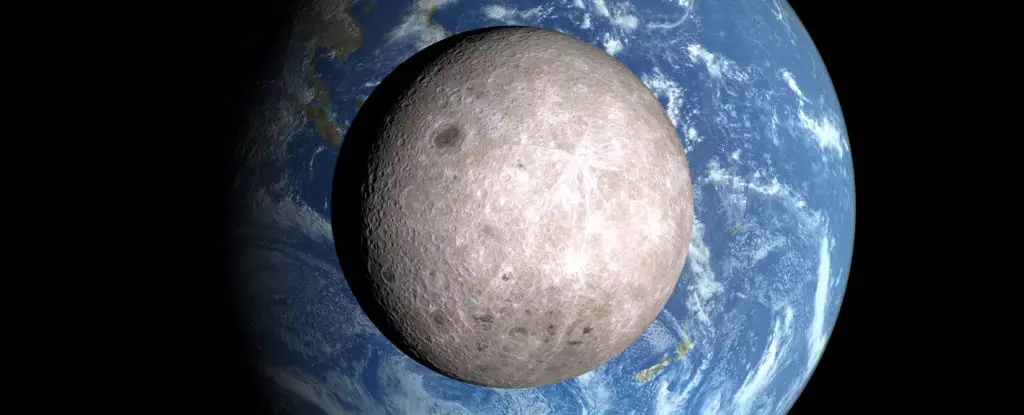Recent studies have unveiled a surprising asymmetry in the distribution of water on the Moon, revealing that the far side harbors significantly less water than the near side. This intriguing finding sheds new light on the Moon’s geological history and formation, challenging our understanding of its evolution since the solar system’s infancy over 4.5 billion years ago. A notable body of research, spearheaded by scientists from the Chinese Academy of Sciences, delves into lunar materials gathered by the Chang’e-6 mission. This groundbreaking endeavor has allowed researchers to analyze the Moon’s far side, providing critical insights into its surface’s stark contrasts and the enigmatic presence of water in its mantle.
Contrasting Landscapes: Near Side vs. Far Side
The Moon’s two hemispheres exhibit distinctly different landscapes; a phenomenon that has perplexed scientists for decades. The near side is characterized by vast, smooth basaltic plains known as maria, remnants of ancient volcanic activity. In contrast, the far side is heavily cratered and rugged, revealing a more primordial surface untouched by volcanic influences. This hemispherical dichotomy raises compelling questions about the Moon’s internal composition and thermal history. Could the disparity in water content provide clues to the processes that sculpted these differences?
Scientists have long hypothesized that the source of this unevenness lies in a massive impact, believed to have occurred early in the formation of the solar system. This theory posits that a Mars-sized body, referred to as Theia, collided with a proto-Earth, sending debris into orbit that eventually formed the Moon. The energy released from this cataclysmic event may have influenced the Moon’s geology, leading to pronounced differences that we observe today.
Water’s Vital Role in Lunar Evolution
Understanding the water distribution within the Moon isn’t merely an academic exercise; it serves as a crucial piece of the puzzle regarding its origin and transformation over time. The research led by Huicun He and Linxi Li asserts that water abundance in the lunar mantle is pivotal for understanding the crystallization processes of the lunar magma ocean and the resultant volcanic activity. The study estimates that the water content on the far side’s mantle is markedly lower, posing significant implications for how we perceive the Moon’s geological narrative.
Water is fundamental for limiting cooling rates and influencing magmatism, potentially impacting volcanic activity for billions of years. The findings from the Chang’e-6 samples indicate that the magma that formed the South Pole-Aitken Basin—one of the largest and oldest impact craters on the Moon—contained only trace amounts of water. This minimal hydration could signify that the area experienced unique geological processes compared to those on the near side, where more extensive volcanic activity gave rise to the maria.
A Closer Look at the Data
The study employed state-of-the-art scanning electron microscopy and electron probe microanalysis techniques to provide an unprecedented look into the mineral compositions of the lunar samples. Their examination focused on identifying signs of hydration in minerals like olivine and ilmenite, only to conclude that the South Pole-Aitken Basin’s basalt was exceptionally dry, with water content around 1 to 1.5 micrograms per gram of rock. The implications of these findings suggest a deeper significance; they could indicate that the geological upheaval caused by the impact may have displaced materials and altered the original water balance on the lunar surface.
The asymmetry in water distribution potentially challenges previous assumptions that postulated evenly distributed water content across the Moon. Instead, it reinforces the theory that the effects of a giant impact—rather than uniform cooling—have played a critical role in shaping the Moon’s current geological state.
Future Endeavors: The Quest for More Lunar Insights
While these initial findings are pivotal, they merely scratch the surface of our understanding of lunar composition. The Chang’e-6 mission represents a monumental leap in exploration, yet it also opens the door for further research. Scientists call for additional missions to the Moon, emphasizing the necessity to obtain more samples from varied locations, particularly on the far side where conditions have been less understood until recently.
Exploring the Moon’s interior composition is not only integral for understanding its past but also has implications for future lunar exploration missions. As nations jostle to establish a presence on the Moon, equipping ourselves with knowledge about its resources—including water—will be essential for sustainable exploration.
As we gaze at this mysterious celestial body, the Moon continues to reveal its secrets, fostering curiosity and inspiring us to venture further into the cosmos. Understanding water’s elusive distribution could ultimately reshape our conception of the Moon’s history and significance in the solar system.

